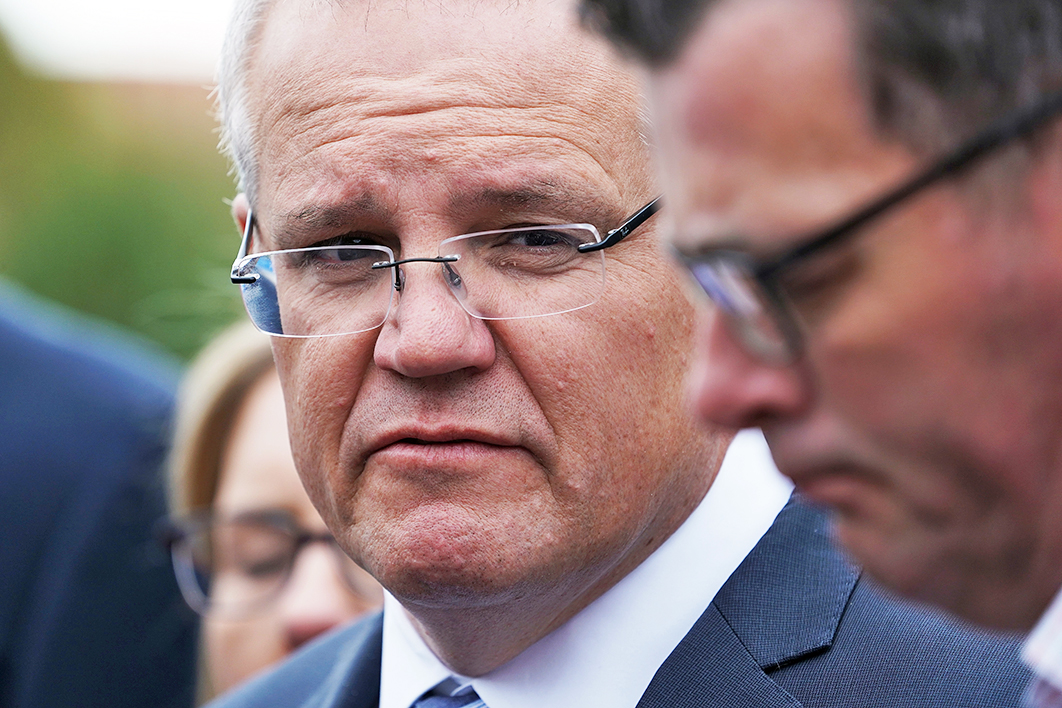Team Australia has disbanded; the Covid-19-induced cross-jurisdictional bipartisanship is over. Scott Morrison has succumbed to pressure from the party room and his wider constituency and joined the pile-on of Victorian Labor premier Dan Andrews. Until this week the prime minister’s annoyance had only been hinted at, or expressed via quiet backgrounders to journalists. Now he’s calling a spade a bloody shovel.
But Morrison was having a lend at his Monday press conference when he repeatedly asserted that because his home town’s current fourteen-day new-case average is greater than five, “Sydney would be in curfew now if it was going on the same plan as Victoria.” Misleadingly framing an opponent’s position is par for the course in politics, and that’s what we’re back to: business as usual.
(His analysis is a furphy for at least the reason that it doesn’t take into account total active cases, which are what spread the virus. On Monday New South Wales had 139 known active cases, while Victoria had 1696. The NSW fourteen-day average of new cases was nine and Victoria’s was eighty-five. When Victoria gets down to nine, it will still have more than 139 total active cases — in fact, it will likely have several times that.)
Writing this from Canberra, which has never had many cases and has suffered relatively few restrictions, I don’t want to understate the misery Victorians, and particularly Melburnians, are experiencing. On and on it goes.
Expert opinion is split on the Victorian premier’s extended lockdown announced on Sunday, although hardly anyone seems to be saying it isn’t harsh enough. The critics point, among other things, to a geographic one-size-fits-all (or at least not enough sizes), too little consultation with business and unnecessary curfews.
You would expect any government to err on the side of caution, not least because it’s better to be able to announce down the track that restrictions are being relaxed earlier than expected than to have to do the opposite (which it did on Sunday). I’m not qualified to judge if it has struck the right balance, nor to assess the assertion that Andrews, having been either health minister or premier for seven of the eleven years since Melbourne’s limited tracing capacity was exposed by the 2009 swine flu, now has an aversion to exploring this continuing shortcoming.
But long before the pandemic, among committed Liberals, Andrews was the most loathed Labor leader in the country. They see him as the most “left wing” of the lot. In fact Victorian Liberal MPs, state and federal, seem to view his very existence as an affront, and many of them have quite evidently been bristling under the Covid-19 political détente. And parts of News Corp, not just Sky After Dark, have also whipped themselves into a “Dictator Dan” frenzy. Everyone’s spending more time these days on the internet, a place not known for its calming influence.
One of the peculiarities of political polling in the age of Covid-19 is that Morrison’s sky-high prime ministerial approval ratings have been accompanied by only modest voting-intention leads for his government. (The Coalition’s longevity in office probably plays a part in this.) The most recent Newspoll (and Newspoll is the pollster the political class obsesses over) had both parties on 50 per cent after preferences, down from a four-point Coalition lead the fortnight earlier. The PM’s personal ratings have also declined from a very high base (although not nearly as much as Andrews’s).
According to Phillip Coorey in the Australian Financial Review this week, “federal sources” attributed the Newspoll findings to “frustration with the Morrison government being unable to influence border closures and other state government impositions.”
A prime minister’s authority rests mostly on perceptions of electability among his or her colleagues. The lower a leader’s standing, the less able he or she is to withstand the demands of excitable colleagues. If you find it hard to believe a change in political rhetoric can be determined by small movements in opinion polls, you haven’t been paying attention to Australian politics in recent decades.
On Monday night Andrews told the ABC’s 7.30 he’s not remotely interested in the politics of the current situation, and that’s probably true in the sense that in the short term, public opinion is almost irrelevant. But he must at times, late at night, ponder his longer-term prospects. He would hope that Victoria will have returned to Covid normality (like the other states) well before Christmas, and all or much will be forgiven.
When the whole crisis is over, all our leaders will derive credit for their handling of Covid-19, but Andrews will always labour under his ultimate responsibility for that second wave. If there were no particular discernible reason for Victoria’s tragic outlier status, or one that was beyond the state government’s control, the mid-term politics would be pretty straightforward: strong leader takes difficult decisions and gets electorate through crisis.
But it’s hard to see Andrews still being premier at the next election in 2022, not (directly) because of Sunday’s or any other announcement, but due to that original sin — those hotel quarantine blunders — which has led to all these deaths and misery. That will always haunt him.
And as for Morrison, now that he’s shown he’s willing to take the gloves off, another political hotspot will demand attention: Queensland, where there’s an election on 31 October. He kept out of last month’s Northern Territory poll, but those days are long behind us.
In fact, as we press publish, that second front has just opened up. •





